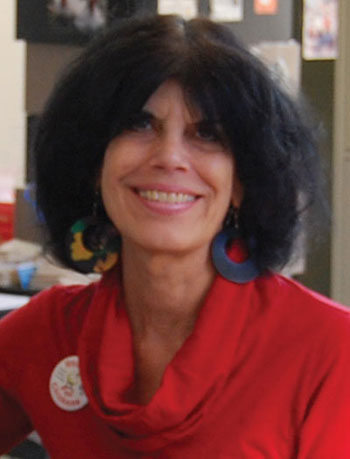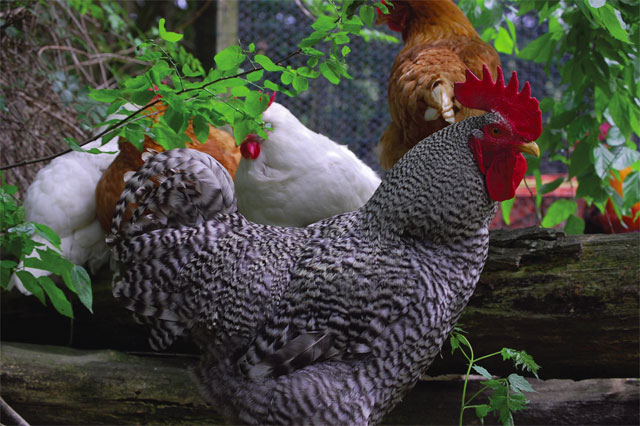If You Give a Cluck, Go Vegan! - Karen Davis
 From a Live Interview with Veganpalooza, August 17, 2013
From a Live Interview with Veganpalooza, August 17, 2013
“Veganpalooza 2013 features world-class vegan leaders providing tools, insights, information, and inspiration to lead healthier, more compassionate
lives, and bringing the vegan message of wellness and kindness into the mainstream in a big way.” – Dr. Will Tuttle, Host & author of
The World Peace Diet
Dr. Karen Davis, founder and president of United Poultry Concerns, is a tireless author and lecturer dedicated to advocating for vegan living. She has
organized eleven annual conferences on animal advocacy issues and her book,
Prisoned Chickens, Poisoned Eggs
, has been recognized for its “brilliant” contribution by the American Library Association.
STEVE PRUSSACK: Hello and welcome to Veganpalooza 2013. I’m your co-host Steve Prussack. It’s great to be with you, and we’re really excited about our
next guest. It’s Dr. Karen Davis and her session titled “If You Give a Cluck, Go Vegan.” To join me in the interview, let’s welcome
to the call our co-host and co-producer Dr. Will Tuttle.
DR. TUTTLE: We are so glad to have you with us because you have a perspective that not only spans decades but is very focused specifically on chickens and other
fowl. Could you please give our listeners some of your insights about why especially chickens but other domestic fowl are so much in need of our concern
and protection today?
DR. DAVIS: Absolutely. One reason is that, traditionally, birds have been considered inferior to mammals. That tradition has been completely discredited by science,
and those of us who live with birds and spend long periods of the day with them know that chickens, turkeys and other birds are very intelligent. I lived
with my parrot Tikhon for 24 years until she died and I learned a lot about avian intelligence from her. But the general public still misunderstands birds.
This misunderstanding particularly affects chickens, turkeys and other birds considered “just food.” In the U.S. alone roughly 9 billion out of
10 billion land animals slaughtered for food each year are chickens and around 250 million turkeys and 25 million ducks. Millions of quails, pheasants,
ostriches, emus, pigeons, and other birds aren’t even counted by the U.S. Department of Agriculture, which lumps them together as
“miscellaneous.”
So we’re looking at three big things. One is the frequent misunderstanding about birds that we need to change; two is that birds are the largest
number of land animals going through food-producing systems as well as being used extensively in laboratory experiments; three is that chickens and other
birds are extremely interesting beings. Birds are wonderful to be around. A chicken yard is full of little dramas and all kinds of socialization and
activities many people don’t realize happen among chickens. One of the great things about our sanctuary is that people get to see our birds among the
trees enjoying a world that is more like the tropical forest in which they evolved.
Photo: Davida G. Breier
 UPC rooster Oliver and his hens
UPC rooster Oliver and his hens
DR. TUTTLE: I know a lot of people think they’re doing something good when they give up red meat. Can you say something about that?
DR. DAVIS: When people decide to eat less or no “red meat” just birds and fish, they cause many more animals to suffer and die because many more small
animals have to be raised, caught, and slaughtered for the same amount of animal flesh. If you see three chicken breasts in a cellophane package and a
bucket of chicken wings, how many birds are you looking at?
There is also the fact that poultry has the same amount of cholesterol as red meat, so there is no improvement from a health standpoint. The birds people
are eating are raised in filthy buildings filled with Salmonella, Campylobacter and other pathogens that make people sick, arthritic, and can even kill
them. There is no basis for thinking it’s healthier switching from red meat to poultry or fish.
DR. TUTTLE: Can you tell our listeners briefly about specific abuses chickens go through, both for eggs and for meat?
DR. DAVIS: Although they’re all the same chickens inside, two types of chickens were bred for industrial poultry and egg production in the 20th century.
So-called broiler chickens grow very large and fast in contrast to the small white birds and brown birds bred specifically for egg production. I remind
people that chickens have legs, wings and claws; they’re meant to dig in the ground, run around, perch, socialize and be active all day.
Suddenly, in the 20th century, chickens were completely immobilized, incarcerated, and not permitted to be active anymore. Debeaking got started.
Egg-laying hens and turkeys are debeaked as soon as they hatch, and ducks are debilled. Even in so-called alternative farming, if hens are going to be used
for eggs, they’re usually debeaked as soon as they’re born. This is an extremely painful procedure because a beak has nerve endings to the very
tip of the beak from the time the bird is an embryo. Debeaking prevents birds from eating and preening their feathers properly because they can’t get
a grip on tiny bits of things.
 Baby turkeys being mutilated on laser debeaking carousel.
Baby turkeys being mutilated on laser debeaking carousel.
Everything I’m saying about chickens applies equally to turkeys. Turkeys have been bred to grow huge in a short amount of time. They’re
slaughtered at three or four months old when they’re basically just coming out of babyhood. They too have heart attacks in their infancy. They too
become lame at an early age, and they are in great pain, the way a person who is extremely overweight develops painful, crippling osteoarthritis.
I want to say a word about the slaughter process.
When birds go into the slaughter plants they are hung upside down on a moving conveyer belt and they are dragged through cold, salted, electrified water.
They are not stunned or intended to be stunned, only paralyzed. Thus, even before their throats are cut, they’re experiencing the agony of electric
shocks in their eyes, their eardrums, their hearts, their whole body. This torture is inflicted so their feathers will come out more easily after they are
dead.
 Photo by L. Parascandola
These fully conscious chickens are electrically paralyzed in agonizing pain.
Photo by L. Parascandola
These fully conscious chickens are electrically paralyzed in agonizing pain.
DR. TUTTLE: So being paralyzed does not mean that they’re insensible to pain.
DR. DAVIS: Just the opposite. They’re filled with a pain we can’t even imagine except to think about how, if you shock your little finger, what a
horrible feeling that is. Imagine electric shocks going through your face and think about all the reports of when executioners are trying to electrocute
somebody on death row, all the terrible torture visited upon one single human being who is intended to be electrocuted, that is, killed by the electricity,
whereas the birds are intended only to be paralyzed and kept alive so their hearts will continue pumping blood until they’re thrown into the
scald-water tanks, often still alive and breathing.
DR. TUTTLE: When people hear that, many say, “That’s not me. I buy a package that says cage-free or free-range” suggesting that either the flesh or
the eggs came from something that’s supposed to be humane. It would be helpful if you could address this issue.
DR. DAVIS: This new phenomenon of going back to the old-fashioned family farm and backyard chicken-keeping and all that – people wanting to keep goats and
expand the number of farm animals in their yards or whatever. Hens used for egg production are not literally in battery cages if they are labeled
“cage-free.” Instead, they’re crowded in buildings, each hen having about a square foot of living space. A lot of cage-free operations
put platforms above the floor – not out of kindness to the birds, so they can perch, but to increase the number of birds in the volume of space. If
you fill up the floor with hens and then add platforms, you can put many more hens in that space.
What often happens is that when hens on the platforms want to jump off, they can’t find a place to land because there’s a sea of birds under
them. So many hens end up with broken bones because they can’t land correctly. There’s also the fact that when hens are kept in extremely
crowded conditions, whether caged or uncaged, they’re not getting the exercise they need, causing their bones to become osteoporotic. Cage-free
means, okay, the birds are not literally in cages, but they are totally crowded and confined, they never get to go outside, and at the end of the laying
cycle, they are slaughtered.
 Black Eagle Farm, a “cage-free” operation in Virginia, houses 48,000 hens. Platforms
Black Eagle Farm, a “cage-free” operation in Virginia, houses 48,000 hens. Platforms
are
designed to cram as many hens as possible into the building. This is a typical
large-scale
commercial operation being advertised as “animal friendly.”
“Free range” means there’s supposed to be some kind of an opening that allows the birds to exit the enclosure for part of the day. But
one of the things we see frequently is that only the birds who are very close to the opening actually venture outside, and the “range” is often
unappealing because it’s just dirt with no foliage or shade or anything.
Chickens come from the forest. The forest is in their genes. They don’t want to be in just a wide open space, with maybe a hawk overhead, and no
place to run for cover.
Then there’s the fact that the U.S. Department of Agriculture does everything possible to help farmers keep their birds inside because farmers want
what is easiest for themselves, rather than what is best for the birds. So they’ll say, for example, “If we let these birds outside and a wild
bird flies overhead and the dropping has an avian flu virus in it, our flocks could get sick, so we’d better keep them inside.” They look for
excuses to not let the birds go out.
There is no such thing as humane animal farming anyway. There never was. Even if people see a sort of happy scene on a smaller farm with green grass and a
few chickens or turkeys around, they don’t see behind the scenes. For example, they don’t see the culling (killing) of animals who are not
growing fast enough or aren’t laying enough eggs or the cow who isn’t producing enough milk or whatever. Farming is about getting rid of every
animal who is not “productive” and killing every animal for food or profit who is. This isn’t just factory farming; it’s animal
farming. It’s economics. Why should farmers feed animals who cost more to feed than they can make money from?
At the end of everything, animals who are not culled or dead of disease on the farm are going to be loaded onto a truck to a slaughterhouse, or if they are
birds, they may be butchered or gassed to death right there on the farm. Many people hope you can have humane slaughter, but the neurophysiology of birds
and other animals is the same as in human beings. The skin, throat and trachea – the whole area you would put a knife through – is filled with
pain receptors and other highly sensitive nerves. You cannot put a knife through the skin and throat of a chicken or any other animal
“humanely.” Humane means Beyond Meat and Animal-Free.
For the entire Interview of which this is an edited portion, please go to
http://www.all-creatures.org/articles/ar-veganpalooza2013-karendavis.html.